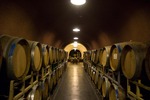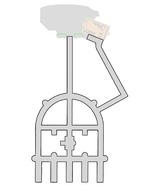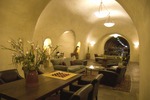 Home Sweet HomeThe Cave is really home to the Cellar Rat, which is why I'm surprised that I haven't spoken more about it. The obvious question is why put wine in a cave in the first place? Wine is picky about its environment. It ages best in a very specific temperature and humidity range that remains constant. Serendipitously, shallow caves happen to provide exactly such an environment. Another modern solution to wine aging and storage is the climate controlled warehouse. It takes a great deal of energy to cool such a large space, so caves are really a much greener option and cost effective as well - I have it on good authority that building a cave is less expensive per square foot than any other structure. Building a modern wine cave is a very exciting endeavor. The digging machine that buried into the earth like a massive mechanical mole looked like the imaginings of Jules Verne.
Home Sweet HomeThe Cave is really home to the Cellar Rat, which is why I'm surprised that I haven't spoken more about it. The obvious question is why put wine in a cave in the first place? Wine is picky about its environment. It ages best in a very specific temperature and humidity range that remains constant. Serendipitously, shallow caves happen to provide exactly such an environment. Another modern solution to wine aging and storage is the climate controlled warehouse. It takes a great deal of energy to cool such a large space, so caves are really a much greener option and cost effective as well - I have it on good authority that building a cave is less expensive per square foot than any other structure. Building a modern wine cave is a very exciting endeavor. The digging machine that buried into the earth like a massive mechanical mole looked like the imaginings of Jules Verne.  Cave FloorplanThe process of digging the cave, we discovered, is very organic: You start with a plan of what you want and then the foreman comes back to you halfway through and says "Okay, we hit granite. You can keep going the way it says on the plan and it will cost you $100,000 or you can go this way and it will cost $10,000." On the original plan the cave is designed like a wheel with spokes leading into the center. It was definitely destiny morphed into the current configuration because the finished cave layout is in the shape of a wineglass.
Cave FloorplanThe process of digging the cave, we discovered, is very organic: You start with a plan of what you want and then the foreman comes back to you halfway through and says "Okay, we hit granite. You can keep going the way it says on the plan and it will cost you $100,000 or you can go this way and it will cost $10,000." On the original plan the cave is designed like a wheel with spokes leading into the center. It was definitely destiny morphed into the current configuration because the finished cave layout is in the shape of a wineglass.
They use the massive machine to dig and cart away the dirt and then they cover the walls with spray-on concrete called shockcrete. The shape of the tunnels provides the real strength of the cave, however, where the winery building will eventually sit on top of the cave, steel girders are stretched into an arch which can hold an enormous load. The strength of this shape has been known since Roman times. Interestingly, it is the concrete floor that holds the ends of the girder in place, so the floor is really what keeps everything together as you can see in the diagram. Another layer of shockcrete is applied and then they cover it with whatever finish you like, such as plaster. In all of the working sections of the cave we left the shockcrete bare because it looks nice but it turned out to be the bane of cellar rats - its jagged surface is as treacherous as volcanic rock. It's slow going when you're working in the tight space between the wall and the barrels.
Deerfield's cave is state-of-the-art: Compressed air is provided throughout the cave, as well as lines for inert gases like nitrogen and argon. There is even copper wire buried in the floor to provide wireless signals! My uncle Martin, our General Manager, even hooked up every switch to our main server, so that potentially, if you wanted to, you could dim the lights from Paris.  The Tasting RoomThe cave is 23,000 sq. ft. and holds about 3000 barrels - that's a lot of wine! Unique to Deerfield's cave is the Grand Room which lays in the very heart of it. This amazing space is currently where our tasting room is located, so when you visit you get to go spelunking. Deerfield’s caves were designed by the winemaker’s brother and my father, Michael Rex.
The Tasting RoomThe cave is 23,000 sq. ft. and holds about 3000 barrels - that's a lot of wine! Unique to Deerfield's cave is the Grand Room which lays in the very heart of it. This amazing space is currently where our tasting room is located, so when you visit you get to go spelunking. Deerfield’s caves were designed by the winemaker’s brother and my father, Michael Rex.